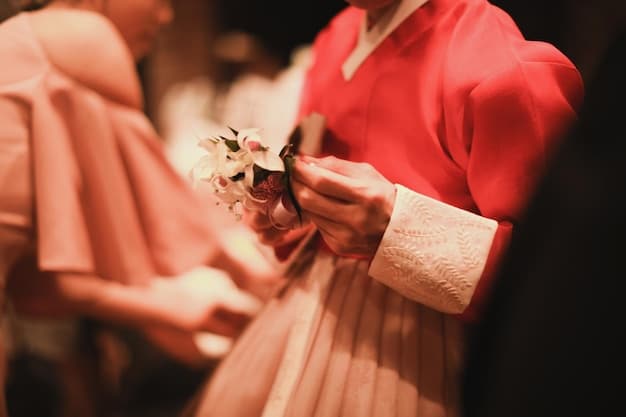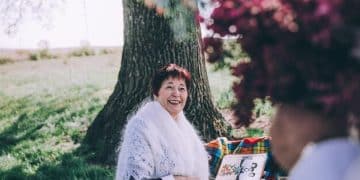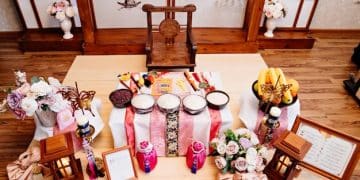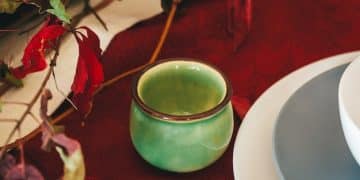Korean Wedding Traditions 2025: A US Guest’s Guide

Understanding Korean Wedding Traditions in 2025 is crucial for US guests to navigate the customs and etiquette, ensuring a respectful and enjoyable experience at the ceremony and reception.
Attending a wedding is a joyous occasion, but when it’s in a different culture, it can feel a bit daunting. Understanding Korean Wedding Traditions: A Guide for US Guests in 2025, is specially crafted to help you prepare for such an event, ensuring you feel confident and respectful while celebrating alongside the happy couple.
Understanding the Core Elements of a Korean Wedding
Korean weddings are a vibrant blend of traditional customs and modern practices. Knowing the core elements will set you up for a successful experience. From the pre-wedding rituals to the reception, each part has significance and beauty.
Pre-Wedding Rituals: Pyebaek
The Pyebaek is a traditional ceremony typically held privately with family members only. However, some modern couples choose to incorporate it into the larger reception. This ritual involves the bride and groom paying respects to their parents and elders.
The Importance of JeonAnrye
JeonAnrye is the presentation of the wedding geese or ducks. These animals symbolize the groom’s fidelity to his bride throughout their marriage. The ritual highlights respect and lifelong commitment.
- Symbolism of Geese: Geese represent a lifelong commitment as they mate for life.
- Respect for Elders: Demonstrates the couple’s respect and gratitude towards their parents.
- Family Unity: Emphasizes the importance of family bonds and ancestral heritage.
These foundational aspects are not just formalities; they are powerful displays of cultural values and familial respect. By understanding them, you’ll appreciate the depth of the wedding ceremony.
Decoding the Dress Code: What to Wear as a US Guest
Navigating the dress code at a Korean wedding can be tricky, but knowing the basics ensures you dress appropriately and respectfully. Generally, formal attire is expected, but there are a few cultural considerations to keep in mind.

Appropriate Colors and Styles
Wearing bright colors is generally acceptable, but avoid wearing white, as this is reserved for the bride. Muted tones like pastels or soft earth tones are good choices. Opt for formal attire, such as a suit for men and a cocktail dress for women.
Avoiding Cultural Faux Pas
It’s crucial to avoid anything too revealing or casual. Korean weddings are formal events, and dressing respectfully shows your consideration for the couple and their families. Additionally, avoid wearing all black, as this is typically associated with mourning.
- Dress Formally: Suits for men, cocktail dresses for women.
- Avoid White: This color is exclusively for the bride.
- Muted Tones: Consider pastels and earth tones over overly bright colors.
By adhering to these guidelines, you demonstrate respect for Korean traditions while still expressing your personal style. Appropriate attire significantly enhances your integration into the celebration.
Gift-Giving Etiquette: Dos and Don’ts for US Guests
Gift-giving is an important part of Korean wedding traditions. Understanding the proper etiquette ensures your gift is well-received and appreciated. Cash gifts are common, and the presentation is just as important as the amount.
The Importance of Cash Gifts
Cash is the most common and appreciated gift at Korean weddings. It allows the couple to use the money as they see fit, whether it’s for their honeymoon or setting up their new home.
How Much to Give
The amount of money you give depends on your relationship with the couple. Close friends and family members typically give more, while acquaintances give a lesser amount. Consider your relationship and financial capability when deciding.

- Use Crisp, New Bills: Ensure the bills are clean and new.
- Place Money in a White Envelope: Use a white envelope specifically designed for monetary gifts.
- Write a Congratulatory Message: Include a heartfelt message to the couple in the envelope.
The presentation of your gift is as important as the gift itself. A well-presented cash gift shows your respect and sincerity to the couple and their families.
Navigating the Ceremony: What to Expect on the Wedding Day
The wedding ceremony itself can be a rich cultural experience. Knowing what to expect will help you navigate the day with ease and appreciation. Be prepared for a blend of traditional and modern elements.
Key Moments in the Ceremony
The ceremony typically includes the exchange of vows, the pouring of wines, and traditional performances. Pay attention to these moments as they hold deep significance.
Respectful Behavior During the Ceremony
Maintain silence during the vows and speeches. Show respect by refraining from using your phone or engaging in side conversations. Being attentive honors the couple and their families.
Understanding the key moments and behaving respectfully is essential. Your attentiveness and involvement will be appreciated, contributing to a harmonious celebration.
Understanding the Reception: Customs and Traditions to Note
The wedding reception is where the celebration truly comes to life. Knowing the customs and traditions will help you participate fully. From the food to the celebratory dances, each aspect contributes to the festive atmosphere.
Traditional Korean Wedding Foods
Korean wedding receptions often feature traditional dishes such as bulgogi, japchae, and various types of kimchi. Enjoying these foods is a great way to immerse yourself in the culture.
Joining in on Celebratory Dances
Don’t be shy about joining in on the celebratory dances. It’s a great way to show your support and have fun with the other guests. Follow the lead of those who are familiar with the dances.
- Try the Traditional Foods: Embrace the opportunity to taste Korean cuisine.
- Join the Dances: Participate in the celebratory dances to show your enthusiasm.
- Toast the Couple: Offering a toast is a great way to express your well-wishes.
Participating in these activities demonstrates your respect and enthusiasm for the couple and their culture. Enjoying the reception fully enhances the overall wedding experience.
Communicating with Respect: Essential Korean Phrases for US Guests
Learning a few key Korean phrases can go a long way in showing your respect and appreciation. Simple phrases can help you navigate conversations and express your congratulations effectively.
Useful Phrases to Learn
Learn phrases such as “Chukha haeyo” (Congratulations), “Kamsahamnida” (Thank you), and “Annyeonghaseyo” (Hello). These phrases can help you engage with guests and show your respect.
How to Use Honorifics Correctly
Korean language emphasizes hierarchy. Use honorifics when addressing elders or those in positions of authority. It’s polite and shows your deference.
- Chukha haeyo: Use this phrase to congratulate the couple.
- Kamsahamnida: Show your gratitude with a simple “thank you.”
- Annyeonghaseyo: Greet others politely with “hello.”
Incorporating these phrases into your interactions demonstrates your respect and willingness to engage with Korean culture. It can significantly enhance your experience and the warmth of your interactions.
| Key Point | Brief Description |
|---|---|
| 🎎 Traditional Attire | Avoid wearing white; opt for muted, respectful colors. |
| 💰 Cash Gifts | Cash is the standard gift; present it in a white envelope with a congratulatory note. |
| 🗣️ Basic Korean Phrases | Learn phrases like “Chukha haeyo” (Congratulations) to show respect. |
| 🍽️ Wedding Feast | Enjoy traditional Korean dishes like bulgogi and japchae. |
Frequently Asked Questions
Avoid wearing white, as that color is traditionally reserved for the bride. It is also best to steer clear of overly casual attire or all-black outfits, which can be associated with mourning.
Only bring a plus-one if your invitation specifically states “and guest.” Korean weddings often have precise guest lists, so it’s courteous to RSVP accurately and avoid uninvited guests.
The amount of money to gift depends on your relationship with the couple. Close friends and family members typically give more, generally ranging from $100 to $300 or more.
The Pyebaek is a traditional Korean wedding ceremony where the bride and groom pay their respects to the groom’s family, particularly his parents and elders. It often involves symbolic gestures and the offering of dates and chestnuts.
Wait for the elders to begin eating before you start. Use chopsticks properly and avoid sticking them upright in your rice bowl. Compliment the food and enjoy the communal dining experience.
Conclusion
By understanding these customs, you’ll be well-prepared to attend and thoroughly enjoy a Korean wedding. Embrace the cultural nuances, participate respectfully, and celebrate the happy couple with confidence and grace.





